Today, I want to take a more in-depth examination of the world of green tea.
For some reason, it’s only been recently that the green varieties of this beverage have become more extensively consumed in the Western world – even surpassing that of the once ubiquitous black teas.

The most popular tea choice in Asia, both today and throughout history, this is also the variety that has been most widely studied by modern science.
For that reason, I first want to take a closer look at all of the proven medicinal benefits that can be gained by regular consumption of this ancient “miracle drink”.
Positive Health Effects
Perfect Amount of Caffeine
The level of caffeine in green tea isn’t nearly as high as that of coffee, so it will never give you the jitters or any of the other side effects that excess caffeine consumption may cause.
It does, however, have enough of it to block the secretion of an inhibitory neurotransmitter called Adenosine.
In so doing, the beverage actually increases the firing of neurons and ups the production of dopamine and norepinephrine, both of which help improve brain function.
Small amounts of caffeine, such as what you get from drinking one cup, result in improvement of mood, attention span, reaction time, and memory.
On top of that, there is an amino acid present in this brew called L-theanine which increases the production of GABA, a neurotransmitter that is proven to help reduce anxiety.
I think we all could use a little more of that in our lives. The combination of low amounts of caffeine and a higher level of GABA is particularly helpful at giving your brain a boost.
Polyphenol Heaven
Green tea has ridiculously high amounts of compounds called polyphenols, which have powerful antioxidant qualities in the human body. They reduce the formation of free radicals, which are known to play a role in the aging process, the formation of cancer cells, and other diseases.

The most potent of the polyphenols is a compound called Epigallocatechin Gallate, or EGCG. The effects of EGCG are the most well-documented, and it has been shown to help treat various diseases.
Green tea has the highest levels of EGCG, which is why it has long been well-known as a medicinal beverage.
Weight-Loss Aid
 Like the oolong varieties, green teas have long been used in the East to aid in weight loss and maintaining a healthy weight. In one study, drinking this powerful beverage increased energy expenditure by 4% and increased fat burning by a whopping 17%.
Like the oolong varieties, green teas have long been used in the East to aid in weight loss and maintaining a healthy weight. In one study, drinking this powerful beverage increased energy expenditure by 4% and increased fat burning by a whopping 17%.
These numbers are probably related to one or more of the polyphenols present.
Additionally, caffeine in and of itself has been shown to help mobilize the fatty acids stored in fat deposits in the body , forcing the body to use them for energy instead of storing them.
Potent Cancer Fighter
In several Asian studies, women who drank the highest amounts of green tea had a 22% lower risk of developing breast cancer. The same studies showed that men drinking the most have a 47% lower risk for developing prostate cancer.
These are, respectively, the number one cancers for each gender. These results show that drinking a few cups a day are well worth it, for this reason alone. Additionally, across both genders, the risk of colorectal cancers diminishes a huge 57%.
Catechin Power
Catechins are the disease-fighting components in all teas, and greens have a very high level of these compounds. These in particular have protective effects on neurons, which may help to lower the risk of developing Alzheimer’s or Parkinson’s disease.
These same compounds kill bacteria and inhibit the growth of viruses, lowering your risk for infections.
Help for Diabetes
Studies show that green tea improves the body’s sensitivity to sugar, controlling your insulin production and keeping blood sugar levels stabilized.
One Japanese study showed that the risk for developing diabetes mellitus type II was lowered by 42% when consuming green tea on a daily basis.
A review of 7 different similar studies showed that on average, the risk was lowered a total of 18%.Whatever the amount, anything that can lower your risk for getting diabetes, the disease that has grown the fastest worldwide over the past decade or two, is something you ought to consider utilizing.
Heart Healthy
Green tea can reduce several main factors that contribute to heart disease, specifically lowering LDL-cholesterol levels as well as the triglyceride levels in the blood.
We all know that having high cholesterol, especially LDL, causes plaque build-up in the arteries which can lead to heart disease and heart attack.

When you look at all the great things consumption does for the body, how can you not add a cup or two a day to your liquid intake?
Now, I know a few people who simply hate the taste of the brewed leaves- I would even venture to say that it’s an acquired taste since it does have some astringent qualities.
It’s nice to know then that you can even buy green tea capsules, in which the dried leaves are powdered and put into a pill form.
Keep in mind, though, that while studies have shown that the EGCG is just as powerful in the capsule, the vast majorities of studies have been conducted on the drink form of green tea.
It may be that some of the components of the polyphenols and catechins are only available when released through heating, as in the steeping process.
The Best Chinese Green Tea Varieties
There are perhaps hundreds if not thousands of different green tea varieties in China alone. Below we’ve offered only a smattering of the types and subtypes.
Click photo for a larger size (may not be mobile friendly)
Lung Ching or Longjing (Dragonwell)
This is perhaps the most famous variety in the world, originating from Hangzhou in the Zhejiang province in China. Longjing translates literally to “dragon well” and is thought to have been named after an actual well of that name near Longjing village.

Longjing tea was granted imperial status after during the Qing dynasty. The emperor’s grandson visited the Hu Gong Temple and was served this tea while there.
He was so impressed with the quality of the beverage that he conferred imperial status on the eighteen tea bushes growing in the temple grounds.
Those same trees are still alive and producing Longjing today (of course they have been propagated many times over so the present worlds supply isn’t produced just from this one temple) .
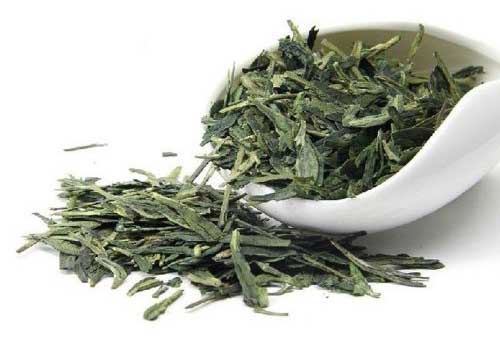
Foodal recommends Longjing Green Premium Dragon Well Loose Leaf by Nature Tea
The pan-firing of the dried leaves gives the liquid a toasty aroma. It has a sweet flavor that has been compared to freshly-roasted corn.
There is also a hint of chestnut-flavor as well. The dried leaves themselves have a very distinctive flat appearance, whereas most loose leaf teas have the leaves rolled into balls.
What to Buy: Dragonwell (Longjing) is surprising difficult to find from any vendors based in the west. Most suppliers ship directly out of China and complaints about old and moldy tea are common.
We found one US based supplier who has a decent quality. We would recommend that you check out Nature Tea’s Longjing Green Premium Dragon Well. They offer 1, 2, 4, and 8oz sizes.
Bi Luo Chun (Green Snail/Spiral Spring)
This highly-regarded variety comes from the Dong Ting Mountain area of the Jiangsu province in China.
Harvested only in the spring, it is made using only the tips of the leaves that are then rolled up tightly, giving it a snail-like appearance, hence the name of Green Snail Spring.
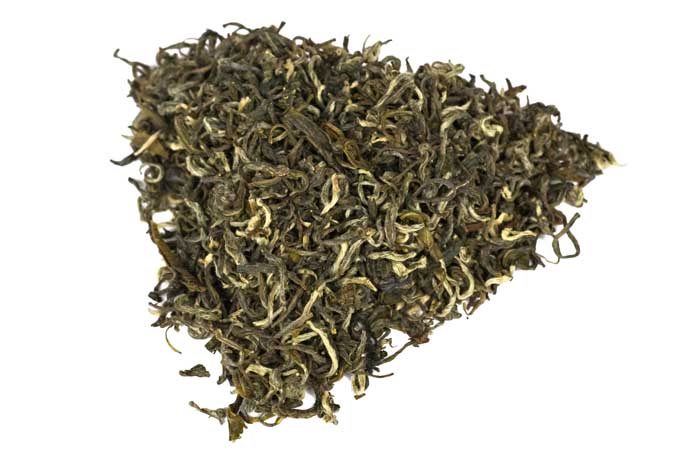
This estate grows their plants in amongst a variety of fruit trees, which gives the resulting beverage a fruity aroma and flavor.
This is a very mellow drink with a bright green appearance and was considered by Zhen Jun, author of the first tea encyclopedia, as the best of the Chinese green varieties.
He ranked the cultivar I mentioned previously, Longjing, as second, and the next variety that I’ll discuss was ranked third.
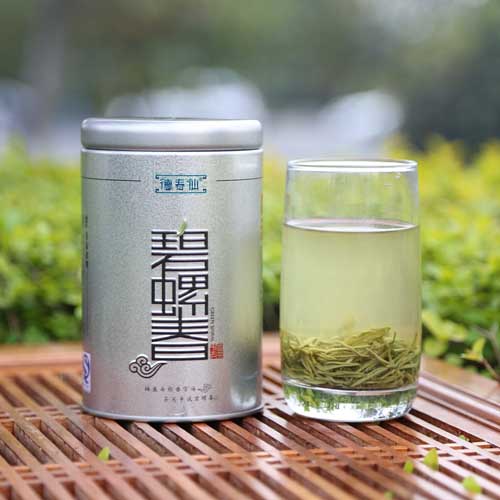
Dechunxian Dong Ting Spiral Spring Green Tea
What to Buy: Again tracking down a decent supplier of this particular type was a bit difficult. However, we did manage to find a decent product courtesy of good old Amazon. We’d recommend that you try out Dechunxian’s Dong Ting Spiral Spring Green Tea. This Dechunxian brand has high marks from other tea drinkers.
Liu An Guan Pian
This variety comes from Liu An County in the Anhui Province of China. Guan Pian is a reference to the shape of the resulting dried leaves, which is similar to that of a white watermelon seed.
This has been one of the most prized Chinese teas since the Tang dynasty (618-907 AD), and it was considered as a tribute tea during the Ming dynasty (1368-1644 AD). It has a mild, almost nutty flavor and, the liquid has a true green color.
Meng Ding Que She (Sparrow’s Tongue)
Grown on the slopes of Meng Ding Mountain, the leaves of this green variety is said to resemble the shape of a sparrow’s tongue (or que she).
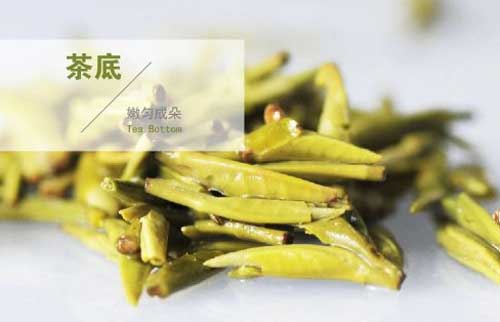
This area is recognized as the birthplace of tea and at one time was the designated production area for the emperor’s annual supply/tribute.
The production was under the strict supervision of Buddhist monks, and each temple had its own tea estate. This resulting beverage has no bitterness at all and has a light and fruity flavor. The drink itself is also a light green in color.
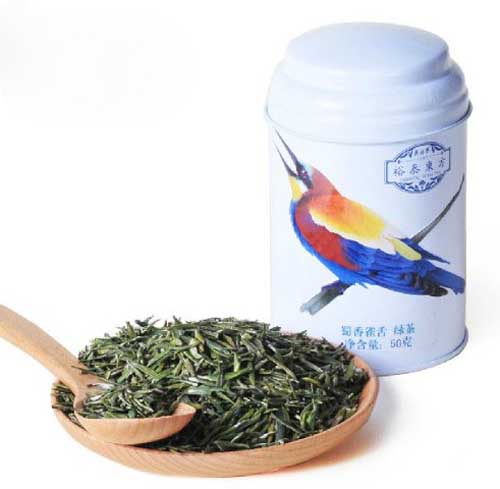
Mingqian Organic Sparrow Tongue Que She Green Tea by Wuyutai
What to Buy: Wuyutai’s Mingqian Organic Sparrow Tongue Que She Green Tea. The Wuyutau company was founded in 1887 and controls some of the best tea plantations throughout the mainland. The company has been reconized by the PRC Commerece Ministry as a “Time Honored Brand.”
Mo Li Hua Cha (Jasmine)
This tea comes from the city of Fuzhou in the renowned tea-producing Fujian province. The city’s official flower is jasmine, so it comes as no surprise that they would use it in their drink.
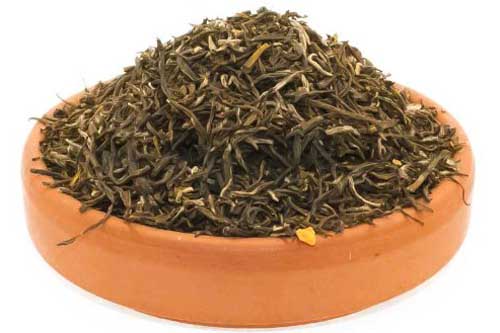
It’s a sweet and delicate beverage with a distinct jasmine aroma and flavor. The tightly rolled tea buds and leaves are mixed with dried jasmine petals to produce the drink, which has been a favorite in China since the Song dynasty (960-1279 AD).
Xin Yang Mao Jian
A very delicate brew, this green is made from the most tender of the silver-tipped leaves from the plants growing in the mountainous Xin Yang region of the Henan province.
As with other varieties, the high-mountain green teas are considered the best quality. This type is a bright and full-flavored drink with a sweet, floral taste.
The liquid itself is more of a light yellow than a true green color.
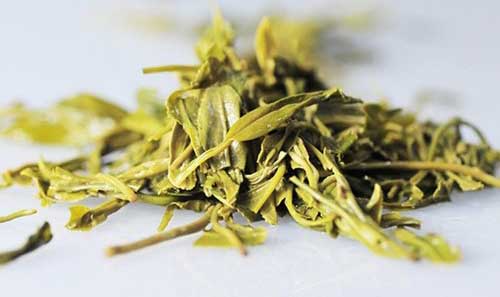
Foodal recommends this High-quality Yuqian Xinyang Maojian Green Tea by Wuyutai
Yun Wu (Clouds and Mist)
This last Chinese variety is more similar to a Japanese green tea than it is to its fellow Chinese varieties. It’s lighter in color and flavor than most Chinese greens and has more of the vegetal taste that you find in Japanese greens.
It can also have something of an earthy flavor and sometimes comes through as slightly nutty, like the flavor of toasted pecans. Like most greens, the leaves for this brew are also only harvested in the early spring.
Yun Wu (Cloud and Mist) – Premium Loose Leaf by Nature Tea (8 oz)
What to Buy: Nature Tea’s loose leaf offering, available in 1, 2, or 8-ounce packages. It’s available on Amazon.
The Best Japanese Green Tea Varieties
I’ll go ahead and point out now, as I mentioned earlier, that Japanese green teas have more of a vegetal, grassy flavor and are also more on the astringent side.
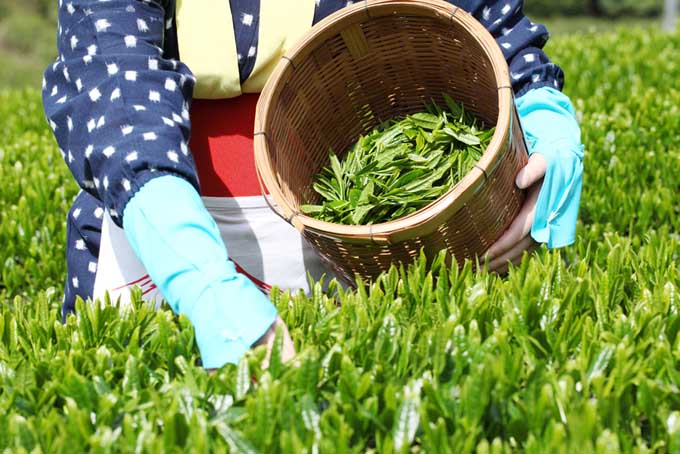
In China, the vast majority of greens are pan-roasted briefly, but in Japan that step is skipped.
Instead, they steam the leaves for a quick 15-20 seconds to stop the oxidation process. Then, the leaves are hand rolled, shaped, and dried.
The very brief steaming period leaves the leaves bright green, and the hand-shaping process gives them a thin, cylindrical form.
Sencha
This is by far the most popular tea in Japan, accounting for over 80% of all production in the country. Shincha is considered the cream of the crop when it comes to sencha.
Roughly translated as “new tea”, this variety is from the first harvest of the year in the early spring. The first leaves that bud in the spring have the most nutrients, as the plants have stored them all up during the winter months.
Perhaps for this reason, shincha is thought to be the most delicious type of sencha.
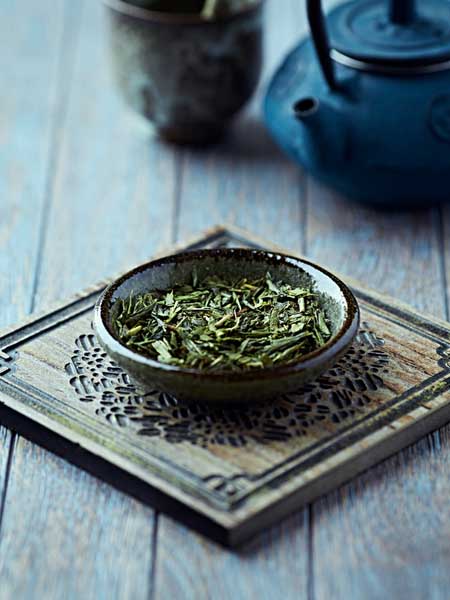
Sencha is a very typical green with a strong grassy flavor. What makes sencha a little unique is that, while when brewed with hotter water it has the typical astringency of the Japanese style, when made with milder water it’s a mellower brew.
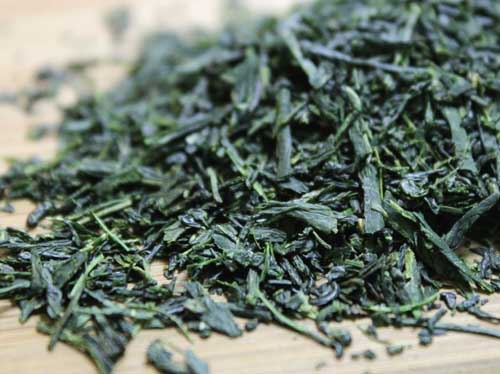
Sencha Tenkaichi Premium Japanese Organic by Tealux
What to Buy: If you like an intense grassy flavor then this Sencha Tenkaichi Premium Japanese Organic by Tealux is just the ticket for you.
In Japanese, “Tenkaichi” means “Number one everywhere beneath the sky” and although that is a bold claim, this is one has a very strong but mannered flavor to back it up.
Gyokuro (Jade Dew)
Gyokuro translates roughly to “jade dew”, a name which is derived from the pale green color of the drink.
While sencha is grown 100% in full sun, gyokuro tea comes from plants that are covered with nets for 2-3 weeks before the leaves are harvested.
The shading contributes to the resulting color and also increases the amino acid theanine, which produces a sweeter tasting beverage than is typical of Japanese greens. Coincidentally, shading also increase the caffeine level as well.
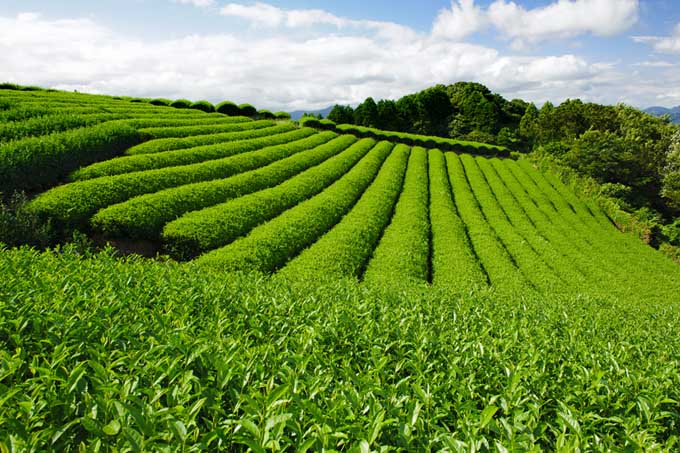
Gyokuro is a much milder tasting brew, and for this reason it is recommended that you double the amount of dry leaves per serving, steep them at a lower temperature than a traditional green tea, and steep the leaves at least 30 seconds longer.
Tealyra Gyokuro Shizuoka Loose Leaf, 3.5 Ounces, available on Amazon
What to Buy: We like the complex flavors produced by Tealyra’s loose leaf offering. It’s a true Gyokuro that has been correctly shaded to increase chlorophyll levels in the leaves and thus improving color, depth, and taste.
Give it a try and you will love it as well.
Kabusecha (Covered)
Like gyokuro, kabusecha also comes from shaded plants, though in this case the nets (called kabuse in Japanese- hence the name) are placed over the plants for just one week.
The flavor and the color will be between sencha and gyokuro.
Tamaryokucha (Coiled), aka Guricha (Curly)
The name of this cultivar is derived from the hand-rolled shape that results in the leaves looking like little commas.
This type may be pan-fried, though most manufacturers resort to the more traditional steaming method as they believe that better preserves the vitamins and antioxidants.
Any pan-fried varieties will have a more pronounced vegetal flavor. After this processing, the leaves are then rolled into their distinctive shape that differs from the more common needle-like sencha.
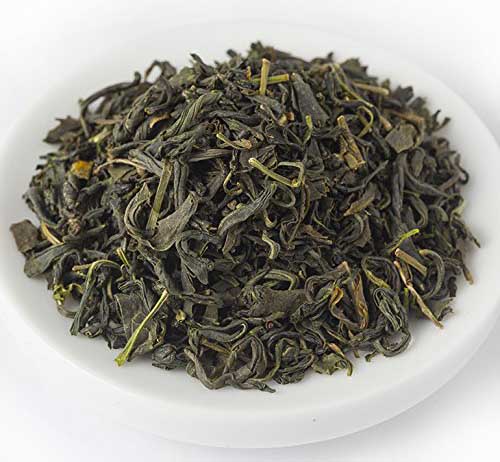
Ureshino Tamaryokucha-Guricha Green Tea by Ota Shigeki Seicha
Tamaryokucha has a very pleasant citrus aroma with hints of grass and berries. The flavor is rather tangy, berry-like, and with a somewhat nutty aftertaste. It makes a truly lovely, golden yellow cup of tea.
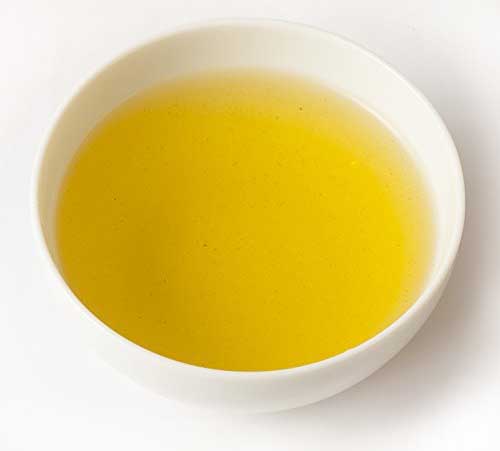
What to Buy: We’d recommend Ureshino Tamaryokucha-Guricha Green Tea by Ota Shigeki Seicha. Originating from Ureshino, Saga Prefecture, this brand is organic and using steaming methods rather than pan frying.
Unfortunately, this variety is not available directly in the US, UK, or Canada but it ships (free) directly from Japan.
Bancha (Coarse)
Sencha is usually harvested in the first flush, or blooming, of the year in the early spring. A second flush follows later in the spring and early summer.
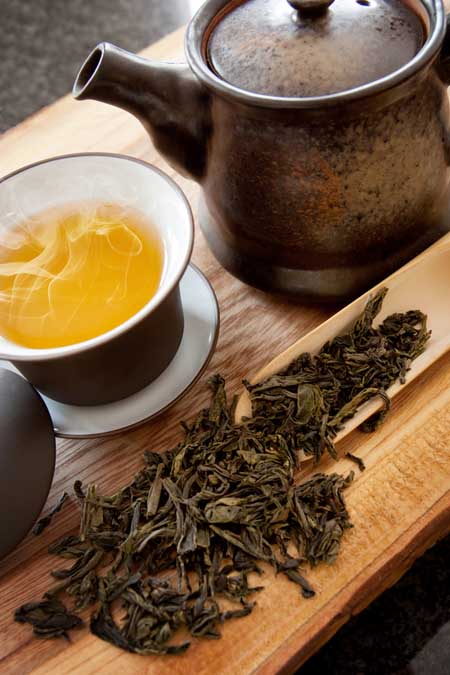
Bancha is harvested in from the third or fourth flush of the year in the late summer and is considered to be a much lower grade of sencha.
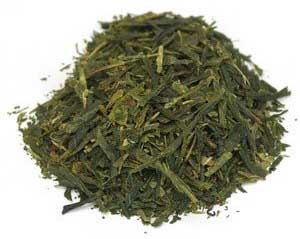
Starwest Botanicals Organic Bancha
A sub-category (which we don’t really recommend) of this variety is aki-bancha, or autumn bancha, and is not even made from actual leaves. It’s made from the twigs of the plant itself.
The resulting drink has an earthy smell and taste and may be somewhat bitter, but it’s considered very refreshing by some.
What to Buy: Starwest Botanical’s Organic Bancha has some great customer review on Amazon. Besides being organic certified by USDA standards, it is also Kosher certified.
Kamairi-cha (Pan-fired)
I’ve already mentioned that in Japan the processing method for tea is usually steaming as opposed to pan-firing, as is common in China.
In the case of kamairicha, however, the Chinese process is used, and the resulting beverage is commonly referred to as Chinese green tea.
After the heating process, the leaves may be either rolled into pellets or left flat. As a result of the roasting process, kamairicha has a somewhat smoky aroma and an earthier, less grassy flavor.
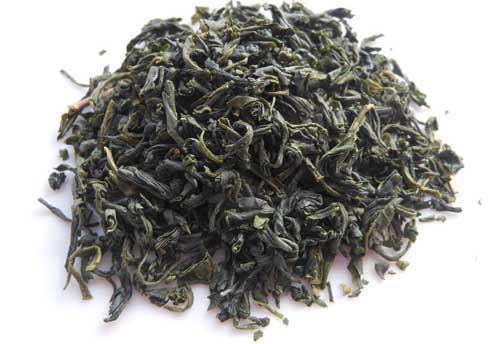
Organic Kamairi-cha Japanese pan-fired green tea from Miyazaki
What to Buy: Our recommendation for Kamairi-cha is the selection offered by Yoco Teas, LTD.
Mrs. Yoco Miyazaki, the company’s CEO, purchases from individual farmers throughout Japan. She find particular cultivars from single farms and develops a relationship with the grower to supply her store in Hamamatsu, Japan with only the best.
Her roasted green teas have won gold medals in various competitions such as the Fair Monde.
Kukicha (Stalk)
Similar to aki-bancha, kukicha is made from the stems, stalks, and twigs of the tea plants. The resulting beverage has a surprisingly creamy feel to it and a mildly nutty flavor.
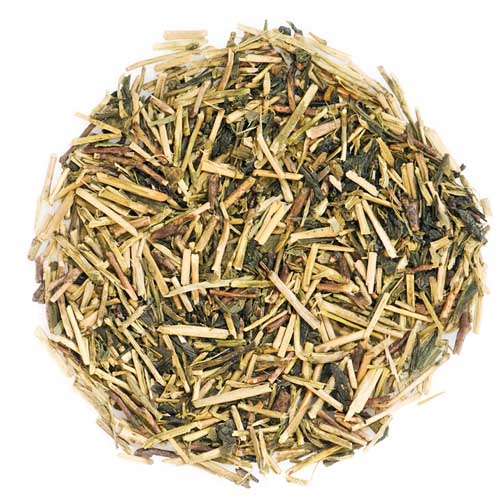
It is brewed with hotter water than traditional green tea.
The majority of the time, kukicha comes from the same plants that are used for sencha or matcha. On occasion, though, it will come from a gyokuro plant.
In this instance, it is called karigane or shiraore.

The Fragrant Leaf, Kukicha Supreme
What to Buy: The greener the better for this type of variety and that is why we recommend The Fragrant Leaf’s Kukicha Supreme.
This one is a higher grade than the average and makes a light and refreshing cup. It’s available in 2, 4, and 8 oz. sizes.
Mecha (Buds and Tips)
This special variety is made using only the leaf buds and tips from the first harvest of the year. It is ranked between a sencha and a gyokuro in quality.
Mecha possesses a unique depth of flavor, very grassy and clean, with a clear, light yellow color. It does have a very astringent quality to it that takes some getting used to, but for this reason it is frequently served with sushi because, like pickled ginger, it helps to cleanse the palate.
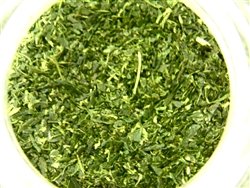
Ejima Japanese Mecha Bud Green Tea
What to Buy: We like the offering by Ejima Tea Company. This is one of the longest continuous tea businesses in Japan and was founded 1661 in Odawara.
The 17th generation of the Ejima family now runs the business. The Ejima family has partnerships with tea growers throughout the Shizuoka region that are in many cases, multi-generational.
Elima’s Mecha offering (you can find it on Amazon) is not for the faint of heart.
Although it is fairly smooth, it is in no way subtle. With strong vegetal overtones in the initial brew, it calms down a bit during the second and third infusion.
Matcha (Powdered)
Okay, folks, this is the last tea I’ll mention, I promise. Matcha is the powdered green tea that is used in the famed Japanese tea ceremony.
This is sencha that has been very finely ground and is considered very high-quality. The flavor of this variety is so popular, in fact, that you can get a plethora of non-tea comestibles in a matcha flavor, such as ice cream.
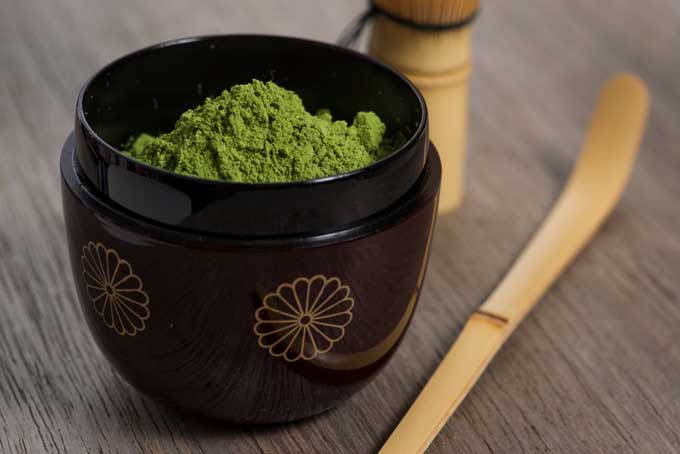
What’s most interesting about matcha to me is that, even though it’s known worldwide as a Japanese drink, it actually originated in China’s Tang dynasty, which ruled from the 7th through the 10th centuries.
During that time, after the heating process, the leaves were formed into bricks for easy transportation and storage.
Then, the amount of tea that as needed was separated from the brick, roasted, and pulverized. The resulting powder was then stirred into hot water.
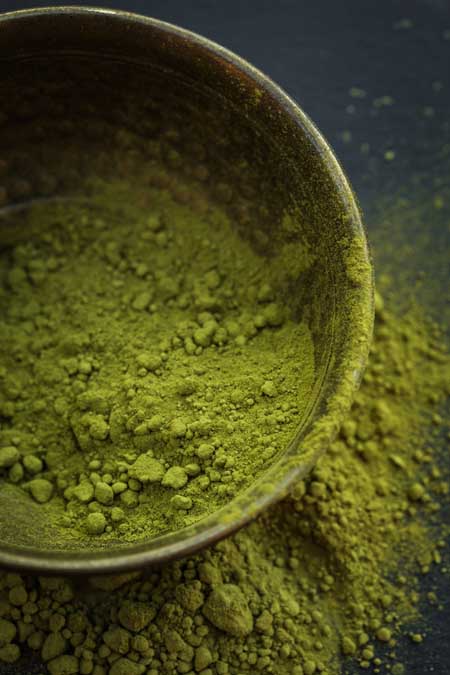
Over time, this method of brewing became ritualized by Zen Buddhist monks. Later on, Zen Buddhism was brought to Japan from China by a monk named Eisai.
He brought with him the tea ceremony as it was recorded in the Rules of Purity for the Chan (Zen) Monastery, written in 1103, which precisely details the exact etiquette required.
Over time, the Zen Buddhists of China disappeared, but their rituals lived on in Japan.
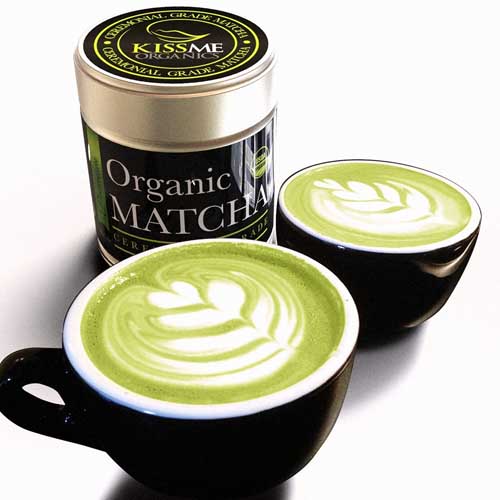
Organic Matcha – Ceremonial Grade – Green Tea Powder
What to Buy: We’d recommend Kiss Me Organic’s USDA certified Organic Japanese Matcha. Despite the trendy name, Kiss Me Organic’s is not an empty brand.
It is a 3rd generation family owned business and farm that has be in operation in the Shizuoka region since 1915.
So Many Teas, So Little Time
Okay, I realize that this may be information overload to some of you, but I can’t help it. The world of green tea is multi-faceted and has so much history and science behind it.
There are just so many different varieties to choose from, each with their own unique qualities. It’s absolutely fascinating, and I totally get why it’s such a huge part of the Asian culture.
Hopefully, this introduction to green tea has piqued your interest enough to give it a try. If you are already familiar a certain variety, maybe this guide has introduced you to a new one that you would like to taste.
Either way, I hope you have been encouraged to tempt your taste buds with something new.
Just make sure that you have adequate storage containers on hand and that you know the best storage and organizing tips, as green tea can lose its vigor fairly quicker (6-8 months) and this can be much sooner if it is exposed to lots of light, air, heat, or moisture.
Want to know more about this marvelous drink? Read all of Foodal’s Tea Guides and Reviews.
Sources
- Health Benefits of Green Tea | WebMD. Retrieved from http://www.webmd.com/food-recipes/features/health-benefits-of-green-tea
- Green tea health benefits examined | Medical News Today. Retrieved from http://www.medicalnewstoday.com/articles/269538.php
- 10 Proven Benefits of Green Tea | Authority Nutrion. Retrieved from http://authoritynutrition.com/top-10-evidence-based-health-benefits-of-green-tea/
About Ashley Martell
Ashley has enjoyed creative writing since she was six years old, when she wrote her first short story. She majored in English literature at the University of Montevallo. After years of professional work, she is now a stay-at-home mom of three, who uses her craft to write about her life and adventures in and out of the kitchen.

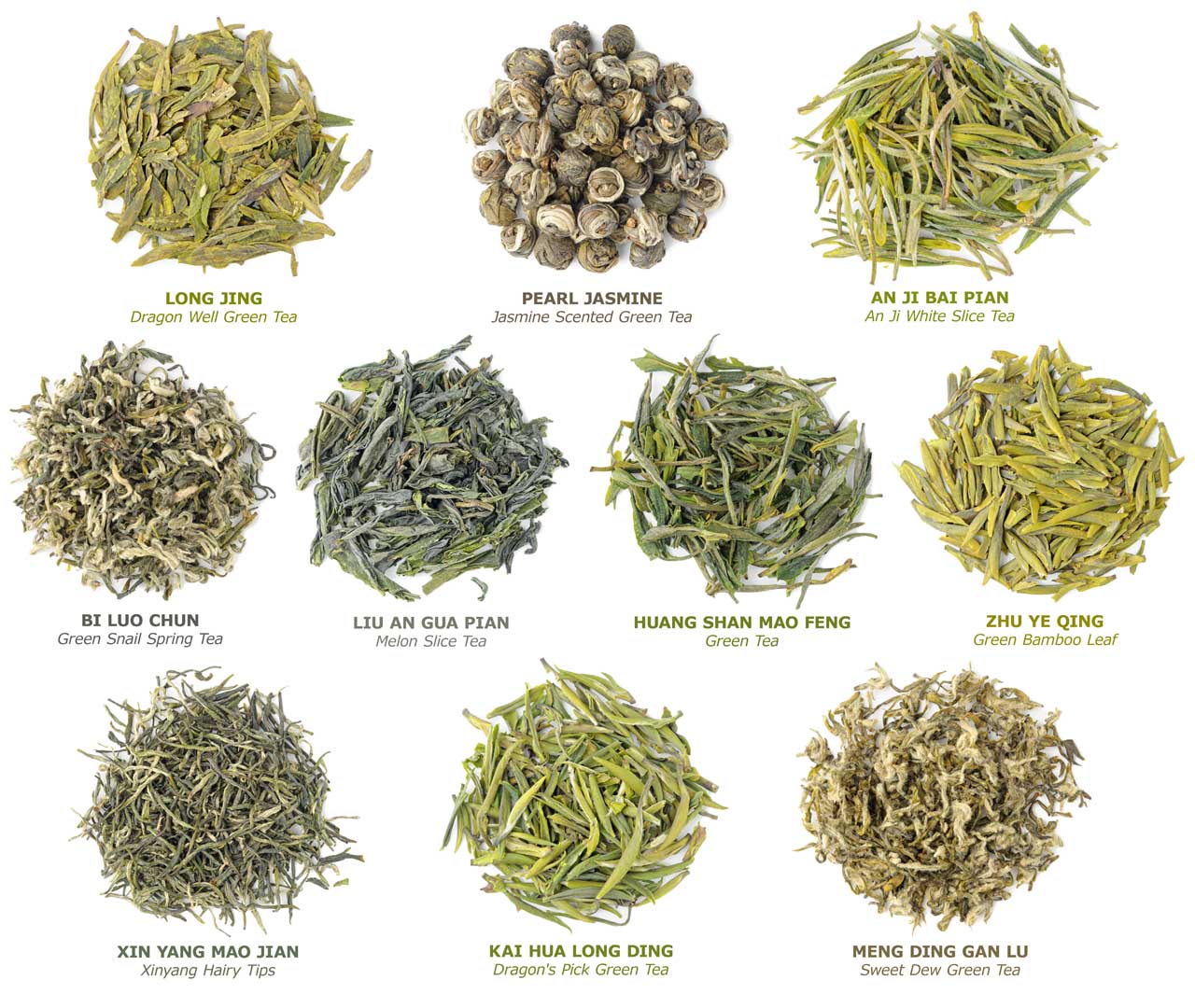
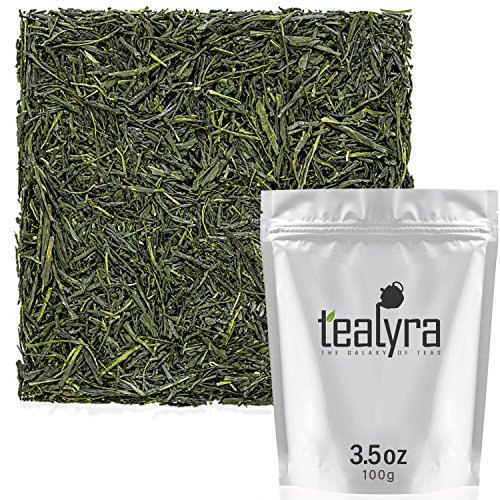
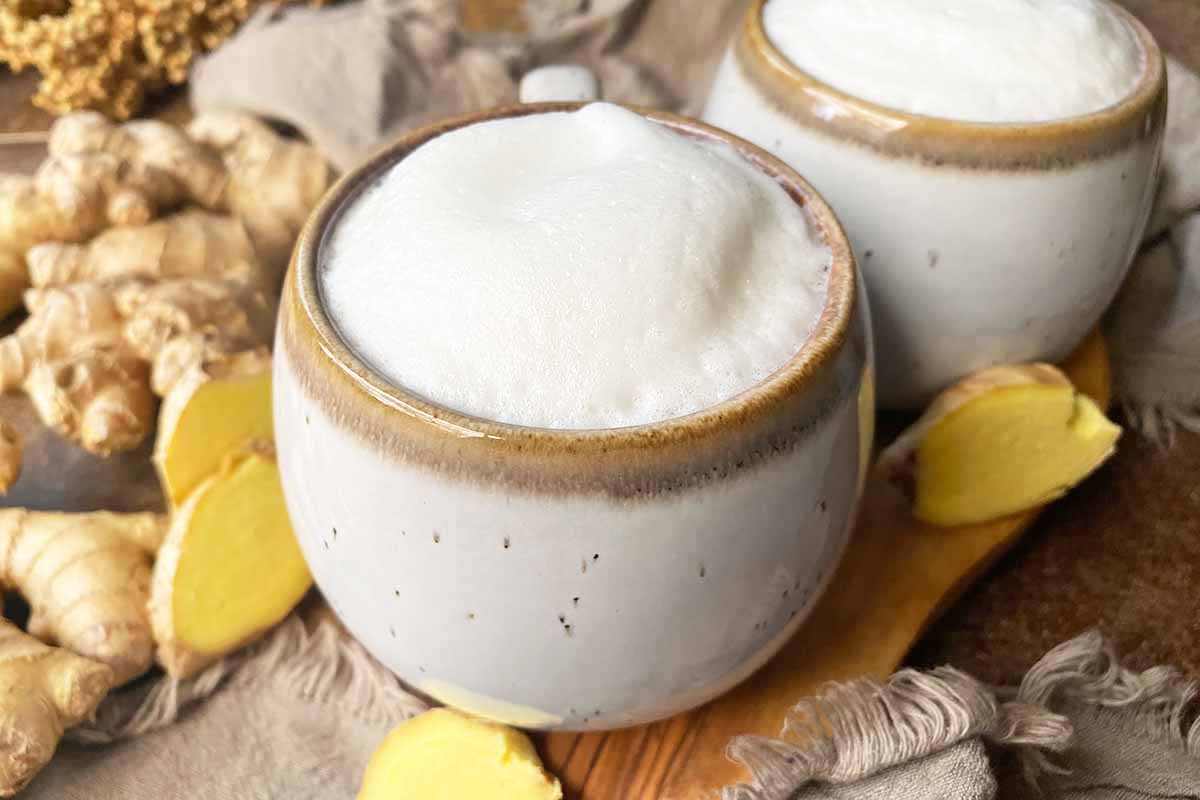
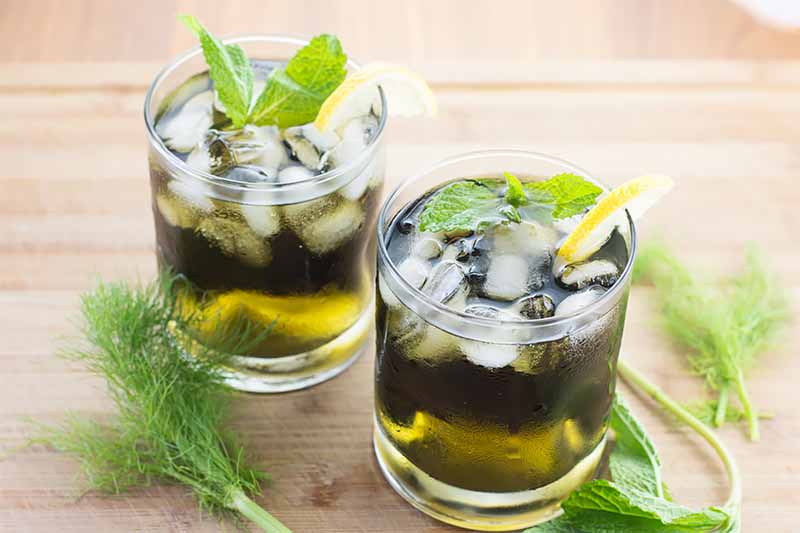
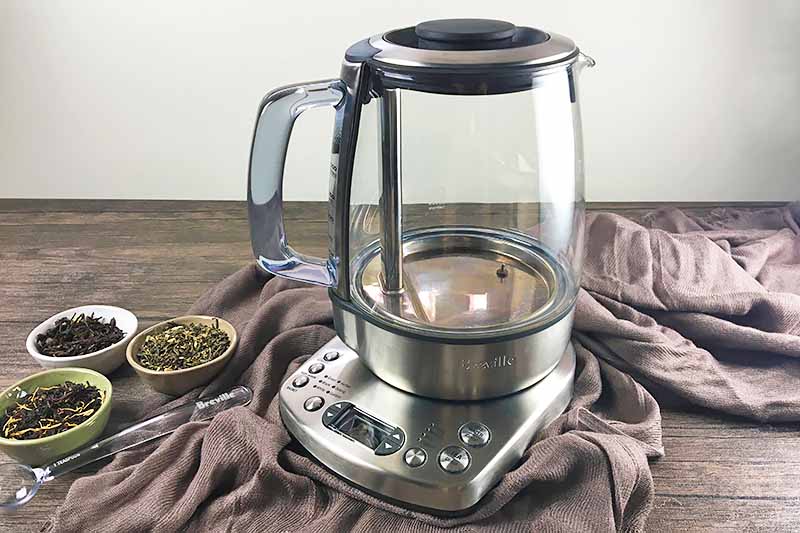
I’ve always been more of a tea than coffee person and I’ve tried every variant available to me. I’ve got to admit that I wasn’t really aware of all the health benefits that it offered, and having a heart condition myself (and diabetes that runs in the family, luckily I’m still not affected) makes it even more appealing. Gonna make me a cup right now!
Wow! That’s a really comprehensive guide you have provided for us. Thank you!
Now I have to say, I join the ranks of the green tea taste haters, but I don’t like the idea of capsules either. I am certainly impressed with all the medicinal advantages of green tea, as well as the weight loss possibilities, so I expect I will have to try it again.
One question, though; when I go to the grocery store, and see a box of tea bags that is labeled green tea, am I to assume it’s not what you have been talking about here? Have I just been buying junk or fake green tea? I guess I’ll have to go online to make my next purchase, if that’s the case.
Thank you for all the details. I have a much better understanding now.
Impressive, this is one of the most comprehensive articles that I’ve read on this website. You touched on the many benefits on green tea and even showcased the many varieties out there.
With all that said though, I’m still reluctant to drink tea, since I don’t consume caffeine but perhaps down the road, I will consider drinking it for all the nutrients!
What an informative article. I have never been a fan of the taste of green tea but I grin and bear it because of the health benefits. I never knew it could be available in capsule form, how eye opening. Also with so many varieties available, perhaps some are more palatable than others? Or perhaps I brew mine too strongly. Either way, this article has inspired me to delve further into the world of green tea as it seems like such a super food.
I remember about a decade ago when green tea became “the thing”. I used to drink it then, but over the years I’ve lost my taste for it. I can’t deal with the bitterness anymore unless it’s iced and sweetened. I won’t how much that negates the health benefits?
I’m another one who isn’t too keen on the taste of green tea. I’ve tried the flavoured green teas though and they were rather nice. Like zeedame though, I wonder if they still offer the same benefits as regukar greent ea.
This was a lot of information Ashley, but it is intriguing all the same. I have been purposely not drinking a lot of green tea, because of concern about the caffeine. So, I appreciate you putting it all in perspective for me. I also like all the health benefits; especially the balancing of blood sugar levels, and the positive effects on the neurons. It is fascinating that there are so many varieties. The only logical (and fun) thing to do is to try one after the other and develop favorites.
It’s great to see more interest in the health benefits to drinking tea. You mentioned catechins which sound almost too good to be true. But actually there is a sizeable amount of medical research going in to the wonder molecules! If anyone’s really science-y, look up ‘catechins’ on PubMed (the government search engine for health & medical research) and just look at all the hits.
Thanks for the super in-depth info! Tea is quickly becoming like wine. I’ve seen a trend lately of adding green tea to other things besides just drinking it as tea. Green tea smoothies, green tea cookies, green tea ice-cream and so on! I think it tastes really good and apparently it also has health benefits, so I’m pretty happy for that trend to continue.
I love that you actually included the neuroscience behind the excellent effects of green tea. I am a huge tea drinker and I haven’t been able to explain to people why it’s so good for you. Now I think I’m just going to direct them to this article. What’s the deal with green tea? Take a look at this!
Green tea is also an excellent alternative source of caffeine, if you’re into the stuff. It’s a better source in fact, because it has a lower concentration per gram so you can tweak your consumption specifically to your needs without ingesting too much.
Coming from an Asian family, we drank green tea like our lives depended on it. We had it pretty much after breakfast, after every meal, and just during any time of the day when we wanted things to drink (we weren’t big on drinking soda growing up). We’ve always used loose-leaf tea also, and it wasn’t until I went off to college when I realized green tea came in a tea bag!
Even now, post college, I try to drink green tea but can only find them in the tea bag form; to me, the tea bag form generally doesn’t give off as much of a taste as loose leaf does so I end up using a lot more tea bags than necessary (which then translates to wasted money). I’ve been meaning to get a good tea pot so I can start using loose leaf tea again, but I have yet to find one that I like for a good price 🙁
Amazing article! Very well structured and a good read!
I personally drink green tea only because it is a source of caffeine, and I can’t stand coffee.
It’s also very good in my opinion and I’ve seen a lot of people that drink it after every meal and instead of other drinks.
I’ve been drinking green tea for a long while now. I have always enjoyed the taste and haven’t really cared or even known about all the health effects. I will certainly be drinking more now. A 47% lowered risk of prostate cancer sounds quite nice.
What an incredible written article! Kudos to the writer!
I’ve been drinking green tea since forever, my mother was a big “fan”, if I could say so! After reading this, I just realized she wasn’t a fanatic over it for nothing. I just drinking it cause it tasted good!
I love most teas, but when I want to relax, I go to green or oolong. I tend to prefer Japanese green, and love the combination of jasmine, green, and oolong. The health benefits are impressive, and there is so much information in this article, I’m going to bookmark it, so I can revisit it before I order more tea.
Wow, what a comprehensive article! I’ve seen some of these varieties, but I didn’t know it was quite so vast. Now I want to try them all, haha. I’ve mostly had Japanese varieties, though I do love jasmine green tea as well. And it’s great to know all the benefits I gain by drinking it.
Thank you for this very informative guide. I consider myself to be a beginner tea drinker and it’s nice to know about all the health benefits. I am looking to buy a Chinese clay tea set online, can you make any recommendations?
A good read. Thanks Ashley. All the health benefits aside, it tastes and smells wonderful. I advised my mom to replace her usual black variety with a green product in our home and told her all about its benefits, we’ve been satisfied with our tea ever since.
“Improvement of mood, attention span, reaction time, and memory?” I keep saying it, but let me say it again. I need to drink more tea! Now that I’m 50 I think it’s truly important – at least based on the benefits noted in this article. I probably should have started drinking more of it many years ago. The issue is the only way I really care for it is sweet. I have tried hot tea with a tbs of honey, but I can’t drink 3 to 5 cups a day with a tbs of honey as that would be too many calories from the honey. Ugh! Don’t get me wrong – I don’t mind the taste of unsweet tea so much. I’ve gotten used to that by now, but unsweet hot tea seems to make me nauseous. I’ll stick with cold I reckon, but I do miss good ole’ southern style fresh brewed sweet tea. If I were skinny I’d probably still drink some from time to time, but alas, I don’t need it.
Who knew there were so many varieties and benefits of tea? Very impressive, detailed article. Thanks!
Wow! I did not know there were so many types of green teas! I am a beginner tea drinker, and am just now learning the wonderful benefits. I have always drank a cup with honey whenever I was sick, but now I realize I should drink more all the time! This is a great article, and thank you for the suggestions on where and what to buy!
“Green tea is green tea if it’s just green tea” – a quote from a favorite Youtuber of mine, pretty fun guy! 😛 This is a pretty in-depth article, I didn’t expect to learn as much stuff as this! 😀 Green tea boosts my energy by quite a lot, I always drink a cup before I go to the gym.
What a great review! I’m sad to say that the Dechunxian’s Dong Ting Spiral Spring Green Tea is currently unavailable on Amazon (but I am signed up to be in the know on when it becomes available again!). I am an avid green tea drinker. Surprisingly enough, instead of becoming a coffee-addicted college student, I took up tea instead with the influence of one of my roommates. I have to agree with you in that it was an acquired taste for me, but once I started drinking regularly I became a true tea connoisseur. I like to splurge on a lot of specialty teas, but I also try to take advantage of the bulk teas offered at many grocery stores.
Thank you for this well informed post! Many people don’t know about the “wonders” of green tea. Green tea has the possibility to help with weight loss and prevent different cancers (as stated above) and yet hardly anyone knows. It can also be used for a variety of preventatives and treatments instead of pharmaceuticals. Also, thank you for putting information about the chemicals that create these effects. Great job!
I looove green tea! It gives me life. I bought myself a cute pug tea strainer in order to enjoy drinking it even more 🙂
I’ve heard that green tea helps you lose weight and boosts your metabolism, so I want to get into habit of drinking it again. It’s so much healthier than coffee (need to stop drinking so much of it).
Well, reading this article might just be enough to get me to put down my morning coffee! Maybe. It’s so hard to give up coffee in favor of green tea, but I can see how much that would benefit me- it’s pretty amazing the health benefits of green tea. I saw a study showing how it protects against certain cancers (lung cancers included) and I was kind of blown away. How can one little leaf do all that? There is a local tea shop in my town that sells a green tea called “Genmaicha”… it’s an infusion tea of green tea and popped brown rice… odd combination that has such an interesting and yummy taste. I look forward to trying the above teas- I’m not going to give up my morning brew for just any old green tea!
I craved green tea with stevia (Truvia brand) while I was pregnant. I knew it was a beneficial beverage, but I didn’t know it was THIS beneficial. Thanks for shedding more light on this awesome drink, Ashley! I’ll definitely grab a cup today because of this article.
I always hear how green tea can help you lose weight. However people say you need to drink like 5 cups for it to actually make a difference. As a coffee drinker 5 cups is way too much caffeine. I do try to opt for tea over coffee occasionally as I know it has a lot of health benefits, especially compared to coffee that usually has milk and sugar.
Oh my goodness Ashley, what an amazing tea journey this post is, I honestly didn’t know there were so many different kinds, I’m definitely going to try some unrecognizable boxes and blends at the Chinese market! I love green tea but now I really will make a point of drinking it on a daily basis, I wonder if it will go well with my morning green smoothie (after letting it cool down a bit). Let’s go put the kettle on!
Green tea is common in some countries but i wish it was the same in mine. I have gotten used to black tea that i,ve forgotten the taste of green tea.
Wow, I knew this stuff was good for you, but it has more benefits than I imagined. I just switched to it from my regular drink, as part of my quest to eat healthier. I’m saving this page to read some more, so I can choose the better selections.
I really like the taste of it too, and I wasn’t so sure that I would. I don’t usually equate “healthy” with “tasty” ha ha.
Thank you for all this great info. I will definitely use this article as a reference.
Wow, great article! Very in-depth and informative. I have only recently began enjoying a cup hot herbal tea on a fairly regular basis. The only hot beverage I drank before was coffee, but the caffeine content can be a problem for me at times. After reading this, I will definitely start drinking green tea for the health benefits mentioned!
Wow… and I thought I had done my research on green tea about a year and a half ago! 🙂 Well, I did, but I didn’t know nearly all of what this article says. I enjoyed it great.
When I was researching, I wanted to find out which of the many varieties actually were the healthiest… and when I had made a decision, I bought some… uh… well, pretty much of it! But now I have some new ones to check into buying and that’s always fun.
Very informative article, thank you for being so thorough. I have always heard of the benefits of drinking Green Tea especially in regards to weight loss and cancer prevention. With so many options of Green tea blends I am interested in knowing however, if there is a significant difference with selecting a more organic blend versus using some of the more popular and mainstream alternatives. I am referring specifically to the brands that target weight loss interest with detoxing and 2 week cleanses. Are these as good as any of the organic blends mentioned in the article?
If this isn’t one of the most comprehensive and informative guides out there, I don’t know what is. At first I had only read about half of it and then I stopped and said to myself “she didn’t cover the Japanese ones!” I scroll down a bit, and bam! The Japanese varieties are right there. The only way this could have been better would have been if you covered the Korean varieties of green tea or Nokcha (녹차). Personally my favorite types are sencha(deep steamed) and pearly jasmine. I think with the latter I just like the way it’s shaped, it tastes good too though. This article has really made me want to try all the different types of green tea. Time to stop buying the pre-boxed ones at the grocery store and splurge on some loose leafed goodness.
Wow, what a fantastic guide to green tea. I got in the habit of a daily cup of green tea last year. My favorite are the jasmine pearl teas. I find the herbs so pretty and I love the delicate scent and flavor. Thank you for these recommendations, I really appreciate the information you gave about these suppliers, and I am making a list of the next green teas to try! Yum!
When I changed my morning coffee to tea, I realized that it’s truly good for your mind and body! Even if it’s not as energizing as coffee, it makes you feel lighter somehow. It reduces your stress and is just the perfect thing to drink if you need a small amount of time for yourself. I knew that there was some health benefits in green tea but never knew there could be that many of them! Thank you for this article, it really enlightened me!
Wow, information overload. I have now successfully identified my variety of gifted Chinese Teas thanks to this article. I have begun to think that everyone should drink green tea. It has so many different health benefits, why isn’t it been drunk more? I knew about several of the benefits and the caffeine content, but never realized that it aided with diabetes as well. Somehow, knowing this information is making me crave a cup of green tea, and now I shall enjoy that much more knowing how much good it is doing for me.
I never realized that there were differences between ones made in China and those made in Japan. It is interesting that the technique is different. I think I like the roasted ones the best. I wonder where and what kinds are the ones predominantly drank in the usa. I also wonder if the ones in this article are organic.
Wow, what a wealth of information regarding one of my favorite subjects! Presently, I am living in Japan, and I have never seen so many tea options. It’s like heaven. Jasmine was one of the types I discovered while living abroad. And while I knew the obvious, like green varieties being ridiculously healthy and chock full of phytonutrients, carcinogen-fighting agents, and other things, I never knew how many types there were and what went into making them. The amount of time and research you put into compiling this data is truly exemplary. I enjoyed reading and learning something new. Thank you.
Now, I’m going to write myself up a list of all the green types I want to try and run to the tea market!
After a visit to China last summer, I was well acquainted with these and many other traditional green flavors! My favorite has got to be the Long Jing and the Tie Gui Yin varieties. They are both very refreshing, and I prefer them to be very dark and concentrated.
A variety that wasn’t covered but I wholly recommend is the Ku Ding Cha (Chinese Bitter). I was never a huge fan of bitter teas, but after I tried it, it slowly grew to be one of my favorites to go along with sweets. It looks just like the Tamaryokucha but it has a very distinct smell and taste.
I can’t wait to try all these other types! Thank you for this wonderful post!
I have had the black tea versus green tea argument several times in my life, way too many in fact, and I have gotten to the point where I just drink both and I don’t want to hear anymore. They both have benefits, but nobody can seem to simplify it for me, so to get all of those benefits I try to drink both, but I strongly prefer back tea to green tea. Something about the taste of green tea just doesn’t do it for me, it is not strong enough. Seeing all these benefits is a quick reminder of why I do it though, so for that I say thank you for sharing.
Very informative article. Thanks for sharing.
Really enjoyed this well-researched article. Green tea is supposed to be very good for metabolism. It also has a host of other benefits like improved sleep, better oral health, etc.